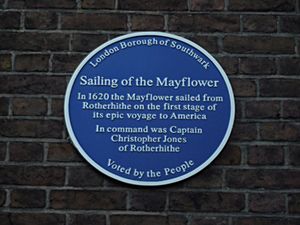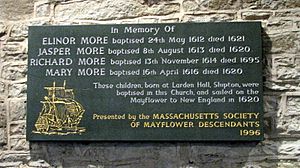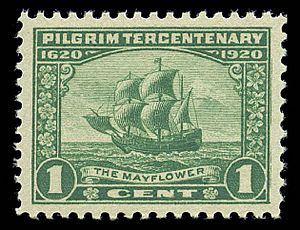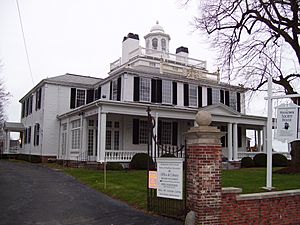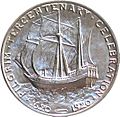Mayflower facts for kids
|
Mayflower in Plymouth Harbor by William Halsall (1882)
|
|
| Name | Mayflower |
| Namesake | Crataegus monogyna (may) |
| Owner | Christopher Jones (¼ of the ship) |
| Maiden voyage | Before 1609 |
| Out of service | 1622–1624 |
| Fate | most likely taken apart by Rotherhithe shipbreaker c. 1624. |
Quick facts for kids General characteristics |
|
|---|---|
| Class and type | Dutch cargo fluyt |
| Tonnage | 180 tons + |
| Length | c. 80–90 ft (24–27.5 m) on deck, 100–110 ft (30–33.5 m) overall. |
| Decks | Around 4 |
| Capacity | Unknown, but carried c. 135 people to Plymouth Colony |
The Mayflower was a famous ship that carried the Pilgrims from Plymouth, England, to Plymouth Colony, Massachusetts, in 1620. This journey was a big step in the early history of the United States.
The ship left England on September 6, 1620. After a very hard trip, the Mayflower dropped anchor near Cape Cod on November 11. The Pilgrims had planned to go to the Hudson River area, north of the Jamestown Settlement.
However, the ship went off course as winter arrived. It stayed in Cape Cod Bay, which had been mapped in 1602. On March 21, 1621, the surviving passengers moved ashore to start Plymouth Colony. The Mayflower then returned to England on April 5.
In 1623, the Mayflower was taken apart for its wood in Rotherhithe, London, England. This happened a year after its captain, Christopher Jones, passed away.
Contents
About the Mayflower Ship
The Mayflower was mainly a cargo ship. It traded goods, often wine, between England and other European countries like France, Norway, Germany, and Spain. From about 1609 to 1622, Christopher Jones was its captain. He was the one who commanded the ship on its famous trip across the Atlantic Ocean.
The ship was based in Rotherhithe, London, England. After its famous voyage, the Mayflower went back to England. It was likely taken apart for its wood in Rotherhithe in 1623. Some people believe that a building called the Mayflower Barn in Buckinghamshire, England, was built using wood from the ship.
We don't know the exact size of the Mayflower. But based on its weight and the usual size of ships back then, it was probably about 90 to 110 feet (27.4 to 33.5 meters) long. It was also about 25 feet (7.6 meters) wide. The ship had a crew of about 25 to 30 people.
Building a Mayflower Replica
A lot of careful work went into building a copy of the Mayflower. This replica is called the Mayflower II. It was launched on September 22, 1956. It was made to look just like the original ship in every way.
Today, the Mayflower II is part of the Plimoth Plantation living museum. You can find it near Plymouth, Massachusetts.
The Pilgrims' Journey

The original plan for the Pilgrims' journey was to use two ships. The other ship was smaller and called the Speedwell. The first time they tried to leave, both ships departed from Southampton, England, on August 5, 1620.
But the Speedwell started leaking and had to be fixed in Dartmouth. On their second try, the ships reached the Atlantic Ocean. However, they had to turn back to Plymouth again because the Speedwell was still leaking.
Later, it was discovered that there was nothing actually wrong with the Speedwell. The crew had damaged it on purpose. They wanted to avoid the year-long contract they had signed for the voyage.
After these problems, the final journey was made by the Mayflower alone. It left Plymouth, England on September 6. The trip lasted 66 days. There were 102 passengers on board, plus the crew. Each family had a very small amount of space for their belongings.
The ship likely had a crew of 25 to 30 people. We only know the names of five crew members, including John Alden. A Pilgrim named William Bradford wrote about the voyage. He said that John Alden was hired as a barrel-maker. He was a promising young man and decided to stay in the new land and get married there.
Arrival in North America
The Pilgrims had planned to go to an area near the Hudson River in "North Virginia". But bad weather pushed the ship far off course. They ended up much further north than they intended. Because of this delay, the settlers arrived in Cape Cod just as a harsh New England winter was beginning. They never reached Virginia, where they had permission to settle.
To create rules and stop arguments among themselves, the settlers wrote and signed the Mayflower Compact. They did this after the ship anchored at the tip of Cape Cod on November 11. This place is now called Provincetown Harbor.
When they first arrived, the settlers explored the snowy area. They found an empty Native American village. The curious settlers dug up some mounds. Some of these mounds held stored corn, while others were burial sites. The settlers took the corn, which caused problems with the local Native Americans, the Nausets.
During the winter, the passengers stayed on the Mayflower. Many got sick with a contagious disease that seemed to be a mix of scurvy, pneumonia, and tuberculosis. By the time the sickness ended, only 53 people were still alive. This was about half of the passengers and half of the crew.
In the spring, the survivors built huts on shore. On March 21, 1621, the remaining passengers left the Mayflower for good. On April 5, 1621, the Mayflower sailed from Plymouth Colony to return to England. It arrived back in England on May 6, 1621.
Mayflower Passengers
The 102 passengers on the Mayflower were the first permanent European settlers in New England. It's important to remember that the Jamestown settlers were the first permanent English settlement in what would become the United States. Many people today are interested in finding out if their family history goes back to one of these Pilgrims. You can find lists of all the passengers and those who died during the first winter.
Throughout that first winter, the passengers spent time on shore. They prepared places for homes and looked for food. But they also stayed on board the Mayflower for part of the time. Only about half of the settlers were still alive when the Mayflower left in the spring. Governor Bradford also wrote that about half of the sailors died.
Another Ship Named Mayflower
In 1629, another ship also named the Mayflower sailed from London to Plymouth Colony. This ship carried 35 passengers, many from Leiden. This was not the same ship that made the original famous voyage with the first settlers. This second voyage started in May and reached Plymouth in August.
The Mayflower in Popular Culture
The Mayflower voyage and the ship itself became famous. It represents a difficult, one-way trip to a new life. Many things have been named after it:
- The Mayflower is the symbol for the English football club Plymouth Argyle F.C.. They are known as "The Pilgrims."
- Songwriter Paul Simon mentions the ship in his song "American Tune."
- Folk/Rock singer Bob Dylan mentions the ship in his song "Bob Dylan's 115th Dream."
- The space-shuttle parody in the movie Airplane II: The Sequel is called Mayflower One.
Many Americans believe their ancestors came "all the way back to the Mayflower."
While the Mayflower brought one early settlement, it's good to compare it to other settlements in North America:
- The Mayflower sailed in 1620. But Virginia had already been settled in 1607 at Jamestown, 1610 at Hampton, 1611 at Henricus, 1613 at Newport News, and other places. Virginia even had a population of about 4,500 people by 1623.
- Also, Albany, New York, was settled by the Dutch in 1614. Santa Fe, New Mexico was settled by the Spanish in 1610. St. Augustine, Florida dates back to the 16th century.
- If we look at Puerto Rico, the towns of Caparra and Old San Juan were the first European settlements in what is now the USA, in 1508.
- Even earlier, about 500 years before Christopher Columbus, the Vikings from Scandinavia had a permanent settlement in Greenland. This settlement lasted from about 1000 A.D. until 1500 A.D.
However, the Mayflower voyage in 1620 is often highlighted. This is because of the "First Thanksgiving" and the peaceful relationship with the native Wampanoag tribe. These events are important to the history of the 13 original colonies of the U.S..
Related Pages
Images for kids
-
Pilgrims John Carver, William Bradford and Miles Standish at prayer during their voyage to North America. 1844 painting by Robert Walter Weir.
-
Mayflower II, a replica of the original Mayflower, docked at Plymouth, Massachusetts
See also
 In Spanish: Mayflower para niños
In Spanish: Mayflower para niños




